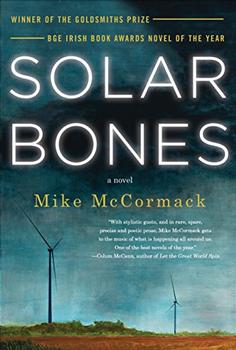Summary | Excerpt | Reviews | Beyond the Book | Read-Alikes | Genres & Themes | Author Bio

This article relates to Solar Bones
Solar Bones is set in the county of Mayo in Ireland, where the narrator can distinctly hear the village church bell ringing its "six chimes of three across a minute and a half;" he refers to it as the Angelus bell.
The Angelus bell is essentially a church bell that rings as a reminder to recite the Angelus prayer. The Angelus prayer recounts the biblical event known as the Annunciation, the moment when the Angel Gabriel appeared to Mary and announced that she was to become the mother of Jesus, the son of God. The ringing of the bell seems to have come into wide use in the 17th century as a means of calling the Catholic faithful to recite the Angelus in the morning, at noon, and in the evening.
The Angelus takes its name from the first line of the prayer in Latin, "Angelus Domini nuntiavit Mariæ," which translates to "The Angel of the Lord declared unto Mary." The Angelus consists of a set of short verses and responses, three recitations of the widely-known "Hail Mary," and a closing prayer. The sound of the Angelus bell coincides with the prayer's recitation, providing three rings for each verse, response, and Hail Mary, and then nine more for the closing prayer.
The Angelus took its current form in the 16th century, evolving from previous practices. A writer for L'Osservatore Romano, the newspaper of the Holy See, provides background on the Angelus, describing the medieval custom that preceded the Angelus as the practice of reciting the Hail Mary three times in the evening, "preceded always by the ringing of a bell so that the brothers and all the faithful nearby would know that it was time for the Hail Mary." As time passed, the practice was extended to both early morning and midday.
 The pause for prayer, invoked by the bell ringing, is depicted in the painting, The Angelus, by Jean-Francois Millet. Believed to have been painted between 1857 and 1859, the painting depicts a man and a woman standing in a potato field; he holds his hat and she folds her hands. Both of their heads are bowed in prayer.
The pause for prayer, invoked by the bell ringing, is depicted in the painting, The Angelus, by Jean-Francois Millet. Believed to have been painted between 1857 and 1859, the painting depicts a man and a woman standing in a potato field; he holds his hat and she folds her hands. Both of their heads are bowed in prayer.
The Angelus call to prayer rings from bells in local churches and monasteries in the unique sequence that invokes the Angelus, although the physical bells themselves could also have served other purposes, such as curfew. According to Catholic.org, "Where the town-bell and the bells of the principal church or monastery were distinct, the curfew was generally rung upon the town-bell. Where the church-bell served for both purposes, [they] were probably rung upon the same bell at different hours." The small number of physical bells surviving from the 13th and 14th centuries suggest that they were intended to be used as a call to recite the Hail Mary because a high proportion of them have inscriptions dedicated to Mary or St. Gabriel.
Bells still ring from churches in Vatican City and in parts of Germany and Ireland and elsewhere, calling the faithful to recite the Angelus prayer. Since 1950, this ringing can also be heard over RTE, Ireland's national public broadcaster. As outlined in an opinion in The Guardian in 2009, the practice has been the subject of some controversy in recent years with critics including secularists, rationalists and constitutionalists contending that a national broadcaster should not transmit a Catholic prayer. However, defenders argue that it is pre-Reformation and a cultural tradition. In a culture piece published in The Irish Times in March of 2017, Donald Clarke asks, "Why do we still broadcast the angelus bongs?" Although polling seems to suggest "unambiguous antagonism towards the Catholic Church," it also finds that 62 percent agree that the Angelus should continue to be broadcast on RTÉ.
To hear a bell ringing a call to the Angelus prayer in Wexford, Ireland, in 2009, click on the video below:
Picture of The Angelus by Jean-François Millet
Filed under Places, Cultures & Identities
![]() This "beyond the book article" relates to Solar Bones. It originally ran in November 2017 and has been updated for the
August 2018 paperback edition.
Go to magazine.
This "beyond the book article" relates to Solar Bones. It originally ran in November 2017 and has been updated for the
August 2018 paperback edition.
Go to magazine.
Your guide toexceptional books
BookBrowse seeks out and recommends the best in contemporary fiction and nonfiction—books that not only engage and entertain but also deepen our understanding of ourselves and the world around us.